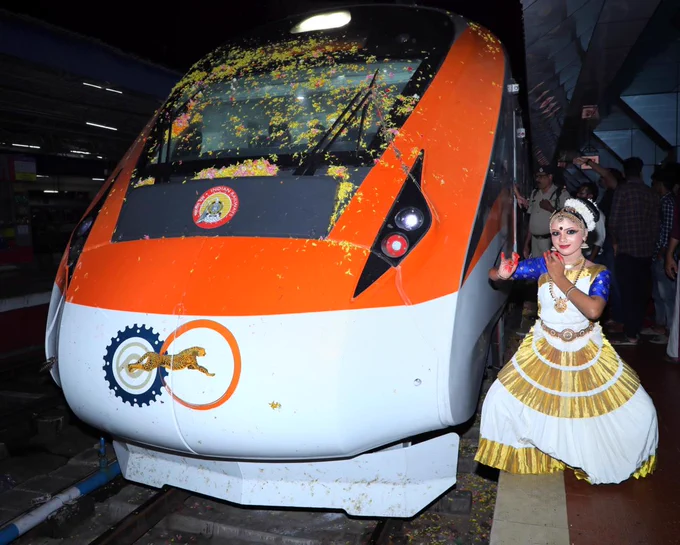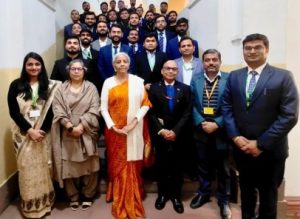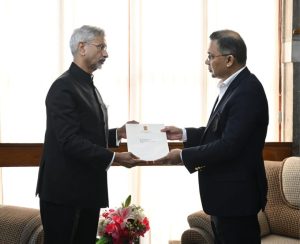Railways go high on Vande Bharat, low on speed amid forgotten Mission Raftar

In a contemporary-classic blend, a Mohiniattam dancer graciously received the Kasaragod-Thiruvananthapuram Vande Bharat Express as it concluded the inaugural run. Credit Ministry of Railways
By Manish Anand
New Delhi, September 25: Prime Minister Narendra Modi in one go flagged off nine Vande Bharat trains on Sunday, and now there are 34 such services connecting various destinations across the country. On August 15, 2021, Modi had set the target to unveil 75 Vande Bharat trains in the next 75 weeks. On February 15, 2019, the first Vande Bharat train was flagged off, which continues to be the fastest running train with an average speed of almost 96 kmph.
Now that 34 Vande Bharat trains are operational, while gaining popularity among the passengers, it’s worthwhile to note that the self-propelled train sets are far from realizing their potential speed capacity. Designed by Integrated Coach Factory, Chennai under the supervision of RDSO, Lucknow, Vande Bharat trains are designed to run at a speed of 160 kmph. But the average speed clocked by them remains just 83 kmph, which is far below the potential.
Unlike China and other countries, India doesn’t have separate semi-high speed or high speed tracks. Passenger and goods trains run on the same tracks. But rail tracks by design and strength can support trains to run up to 200 kmph, and 160 kmph is surely within the reach. Yet, Vande Bharat trains lag behind the likes of Shatabdi Trains, which average 91 kmph. Even Rajdhani Express, Gatiman, and Tejas run faster than Vande Bharat.
The fault is surely not with Vande Bharat, which is indeed an achievement for India to develop an indigenous product on the basis of in-house engineering talent pool. Before Vande Bharat was designed in record 18 months, the Ministry of Railways had floated tenders to import semi-high speed train sets, and Telgo had taken part in the trial run on Nizamuddin-Bhopal route.
Why speed not scaled up?
Despite tracks capable to support trains running at 160 kmph and a little more, the average speed remains sub-100, principally because the tracks are not fenced. If tracks are fenced and there is no risk of human or stray cattle coming in the way of the speeding trains, India can potentially see the passengers and the goods reaching their respective destinations far more quickly.
Except for the Hazrat Nizamuddin (Delhi)-Agra section, no part of tracks anywhere in India are fenced. Russia for instance has tracks with ditches on both sides with mounds scaled up to ensure that no impediments can come in the way of the running of the trains.
Railways expert Sanjay Singh argues that the Ministry of Railways has essentially focused on doubling and tripling of tracks in the name of capacity augmentation and the idea of laying new tracks to solely cater to trains running at higher speed never paid attention to by the Railway Board. Besides Vande Bharat has front design made of reinforced fibre which gets damaged when hit by stray cattle. This is unlike other trains which have front parts made of steel with suitable designs of nets to protect against hits by the stray cattle.
Whither Mission Raftar?
The Comptroller and Auditor General (CAG) in a report submitted in parliament in 2022 said that “Indian Railways despite investing Rs 2.5 lakh crore on track infrastructure during 2008-19 have failed to improve on the mobility outcomes. Mission Raftaar, introduced in 2016-17, targeted an average speed of 50 kmph for mail/express and 75 kmph for freight trains by 2021-22. The average observed speed of Mail/Express and freight trains until 2019-20 was, however, still around 50.6 Kmph and 23.6 Kmph, respectively”. The Railways, however, maintain that the freight trains achieved an average speed of 41.2 kmph by 2021-22.
The Mission Raftar mandated that the speeding of the passenger and freight trains would be incumbent on modernization of tracks, signaling, and changes in coach designs. Most of the passenger trains, including almost all the premium trains, have shifted to LHB (Linke Hoffmann Busch) from the old ICF coaches.
Why tracks be fenced?
The Ministry of Railways is going big in commissioning Vande Bharat trains, and the policy vision has already stated that sleeper versions will also be introduced. Clearly, the policy shift is on self-propelled Vande Bharat trains, because of several positives about it, including train sets being energy cost-effective, it’s incumbent on giving momentum to Mission Raftar, with thrust on fencing tracks with barbed wires or cement walls to eliminate scope of any obstruction for the running trains. This will also seek freeing of encroached land of the railways. Ober 782 hectare of railway land is under encroachment, according to the reply of the Ministry of Railways in parliament, and mission-mode fencing of tracks would require freeing them up.
Also, dedicated freight corridors have target of December, 2023 for completion, though roughly 66 per cent has so far been completed, which will help the railways to run more passenger trains on the existing tracks. Goods trains will run at average 100 kmph speed on dedicated freight corridors, and passenger trains will get freed up tracks to run at higher speed, which will not be possible until track-fencing is done.
Status of eliminating level crossing
At the same time, the Railways is working on elimination of surface crossing by constructing Rail Over Bridges (ROBs) and Rail Under Bridges (RUBs). The Ministry of Railways in a reply to a question in the Lok Sabha said that “construction of ROBs/Road Under Bridges RUBs is taken up to eliminate manned level crossing gates … Priority of elimination of level crossing (LC) is based on its impact on safety in train operations, mobility of trains, impact for road users and feasibility, etc. During 2014-2023, total 1654 ROBs and 9213 RUBs have been completed and Rs. 30602 crores have been spent”. Union Minister for Railways Ashwini Vaishnav had also stated that as on July 25, 2023, a total 1863 ROBs and 2490 RUBs have been sanctioned over all Zonal Railways, which are in different stages of planning and execution with an allocation of Rs. 8000 crores during the year 2023-24, out of which Rs. 1549 crores have been utilized up to June 2023”.






